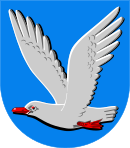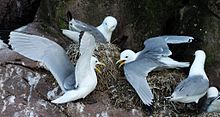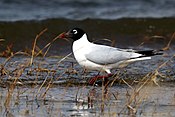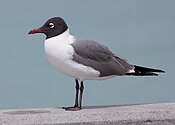
Seabirds are birds that are adapted to life within the marine environment. While seabirds vary greatly in lifestyle, behaviour and physiology, they often exhibit striking convergent evolution, as the same environmental problems and feeding niches have resulted in similar adaptations. The first seabirds evolved in the Cretaceous period, and modern seabird families emerged in the Paleogene.

Terns are seabirds in the family Laridae that have a worldwide distribution and are normally found near the sea, rivers, or wetlands. Terns are treated as a subgroup of the family Laridae which includes gulls and skimmers and consists of eleven genera. They are slender, lightly built birds with long, forked tails, narrow wings, long bills, and relatively short legs. Most species are pale grey above and white below, with a contrasting black cap to the head, but the marsh terns, the Inca tern, and some noddies have dark plumage for at least part of the year. The sexes are identical in appearance, but young birds are readily distinguishable from adults. Terns have a non-breeding plumage, which usually involves a white forehead and much-reduced black cap.

The black-headed gull is a small gull that breeds in much of the Palearctic including Europe and also in coastal eastern Canada. Most of the population is migratory and winters further south, but some birds reside in the milder westernmost areas of Europe. The species also occurs in smaller numbers in northeastern North America, where it was formerly known as the common black-headed gull.
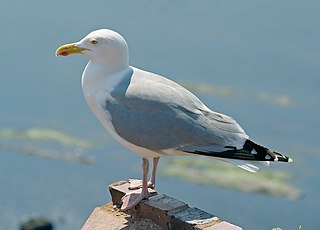
The European herring gull is a large gull, up to 66 cm (26 in) long. It breeds throughout the northern and western coasts of Europe. Some European herring gulls, especially those resident in colder areas, migrate further south in winter, but many are permanent residents, such as in Ireland, Britain, Iceland, or on the North Sea shores. They have a varied diet, including fish, crustaceans, as well as some plants, and are also scavengers, consuming carrion and food left by or stolen from humans.

The great black-backed gull is the largest member of the gull family. Described by the Cornell Lab of Ornithology as "the king of the Atlantic waterfront", it is a very aggressive hunter, pirate, and scavenger. It breeds on the European and North American coasts and islands of the North Atlantic and is fairly sedentary, though some move farther south or inland to large lakes and reservoirs. The adult great black-backed gull has a white head, neck and underparts, dark grey wings and back, pink legs and yellow bill.

The little gull, is a species of gull belonging to the family Laridae which is mainly found in the Palearctic with some colonies in North America. It breeds on freshwaters and spends winters at sea. It is the smallest species of gull in the world and the only species in the monospecific genus Hydrocoloeus.
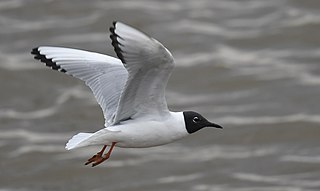
Bonaparte's gull is a member of the gull family Laridae found mainly in northern North America. At 28 to 38 cm in length, it is one of the smallest species of gull. Its plumage is mainly white with grey upperparts. During breeding season, Bonaparte's gull gains a slaty-black hood. The sexes are similar in appearance.

The roseate tern is a species of tern in the family Laridae. The genus name Sterna is derived from Old English "stearn", "tern", and the specific dougallii refers to Scottish physician and collector Dr Peter McDougall (1777–1814). "Roseate" refers to the bird's pink breast in breeding plumage.

The yellow-legged gull is a large gull found in Europe, the Middle East and North Africa, which has only recently achieved wide recognition as a distinct species. It was formerly treated as a subspecies of either the Caspian gull L. cachinnans, or more broadly as a subspecies of the herring gull L. argentatus. The genus name is from Latin Larus which appears to have referred to a gull or other large seabird, and the species name honours the German zoologist Karl Michahelles.

The Aleutian tern is a migratory bird living in the subarctic region of the globe most of the year. It is frequently associated with the Arctic tern, which it closely resembles. While both species have a black cap, the Aleutian tern may be distinguished by its white forehead. During breeding season, the Arctic terns have bright red bills, feet, and legs while those of the Aleutian terns are black.

The grey-headed gull, also known as the gray-hooded gull, is a small species of gull which breeds patchily in South America and Africa south of the Sahara. It is not truly migratory, but is more widespread in winter. This species has occurred as a rare vagrant to North America, Italy and Spain. As is the case with many gulls, it has traditionally been placed in the genus Larus.

The greater crested tern, also called crested tern or swift tern, is a tern in the family Laridae that nests in dense colonies on coastlines and islands in the tropical and subtropical Old World. Its five subspecies breed in the area from South Africa around the Indian Ocean to the central Pacific and Australia, all populations dispersing widely from the breeding range after nesting. This large tern is closely related to the royal and lesser crested terns, but can be distinguished by its size and bill colour.

The black-legged kittiwake is a seabird species in the gull family Laridae.

The silver gull is the most common gull of Australia. It has been found throughout the continent, but particularly at or near coastal areas. It is smaller than the Pacific gull, which also lives in Australia.

The California gull is a medium-sized gull, smaller on average than the herring gull, but larger on average than the ring-billed gull. It lives not just in California, but up and down the entire Western coast of North America, and has breeding ground inland. The yellow bill has a black ring.

The swallow-tailed gull is an equatorial seabird in the gull family, Laridae. It is the only species in the genus Creagrus, which derives from the Latin Creagra and the Greek kreourgos which means butcher, also from kreas, meat; according to Jobling it would mean "hook for meat" referring to the hooked bill of this species. It was first described by French naturalist and surgeon Adolphe-Simon Neboux in 1846. Its scientific name is originally derived from the Greek word for gull, "Glaros" and via Latin Larus, "gull" and furca "two-tined fork". It spends most of its life flying and hunting over the open ocean. The main breeding location is in the Galápagos Islands, particularly the rocky shores and cliffs of Hood, Tower and Wolf Islands, with lower numbers on most of the other islands. It is more common on the eastern islands where the water is warmer.

Hartlaub's gull, also known as the king gull, it is a small gull. It was formerly sometimes considered to be a subspecies of the silver gull, and, as is the case with many gulls, it has traditionally been placed in the genus Larus but is now placed in the genus Chroicocephalus. The species’ name commemorates the German physician and zoologist, Gustav Hartlaub.
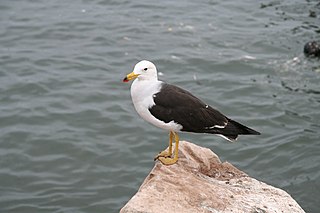
Belcher's gull, also known as the band-tailed gull, is a bird in the family Laridae found along the Pacific coast of South America. It formerly included the very similar Olrog's gull as a subspecies, but that bird occurs on the Atlantic coast of South America and is now accepted as Larus atlanticus. Belcher's gull is a medium-sized gull with a blackish mantle, white head and underparts, a black band on the otherwise white tail, and a yellow bill with a red and black tip. Non-breeding adults have a brownish-black head and a white eye-ring. The name of this bird commemorates the British explorer Sir Edward Belcher who performed survey work on the Pacific coast of South America.

Saunders's gull or the Chinese black-headed gull, is a species of gull in the family Laridae. It is found in China, Japan, North Korea, South Korea, Macau, Russia, Taiwan, and Vietnam. Its natural habitats are estuarine waters and intertidal marshes. As with many other gulls, it has traditionally been placed in the genus Larus, but based on phylogenetic work some have moved it to Chroicocephalus, while others argue it is sufficiently distinct for placement in the monotypic Saundersilarus. In 2023, this transfer was recognized by the International Ornithologists' Union.

The American herring gull or Smithsonian gull is a large gull that breeds in North America, where it is treated by the American Ornithological Society as a subspecies of herring gull.




